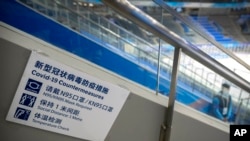Visitors who come to China for the 2022 Winter Olympics in Beijing over the next several weeks will be met by medical workers.
The workers will give the visitors a test for COVID-19 and test the surfaces of the things they carry with them. Once the visitors test negative, they will be taken to their hotels in special vehicles.
Compared to the “bubble” at the recent summer Olympics in Tokyo, the bubble in China is more restrictive. Guards are visible in many places. Visitors and athletes are not permitted to leave the protected area until they go home.
The restrictions are in place as many countries around the world are seeing a surge in coronavirus cases of the Omicron variant. In China, however, the number of cases is small as the country still maintains a “zero-tolerance” policy.
In addition to the sports competitors and visitors, about 20,000 Chinese volunteers and workers will be inside the bubble.
The Chinese government is warning regular people to stay away from the Olympics. If their car is in an accident with an Olympic vehicle, they are asked to stay away and wait for special police.
The closed area is being called a “loop.” It opened on January 4 and will be fully active starting on January 23 through the end of the Olympics, which begin on February 4.
If people need to leave the bubble, they are only permitted to do so in special vehicles.
Olympic organizers said they expect some COVID-19 cases inside the loop, but they do not plan to change the rules unless there are many cases.
No fans from outside China will be permitted to watch the events in person and China has not yet said how many local people will be able to watch.
China has limited the spread of the virus since it was first identified in the city of Wuhan over two years ago. Foreign travelers have not been permitted to come to China so the large number of international visitors is a test for the nation.
Michael Baker is a professor of public health in New Zealand. He said it will be difficult for China to prevent the spread of the Omicron variant. But, he noted, the Olympics have a clear start and end date and it can be “tightly controlled.”
Everyone inside the loop will get a COVID-19 test given by a health care worker each day. If someone needs to leave their room, they must have a green code which means tests show they did not have the virus in the last 24 hours.
About 27,000 visitors will come to China soon, including 2,000 athletes. People inside the loop will not be able to order food from outside of the loop. Inside eating areas, robots will help bring food to tables.
I’m Dan Friedell.
Dan Friedell adapted this story for Learning English based on a report by Reuters.
Do you think the Olympic bubble will keep people in China safe from COVID-19? Write to us in the Comments Section and visit our Facebook page.
_________________________________________________________________
Words in This Story
negative – adj. not showing the presence of a particular germ, condition, or substance
bubble – n. a group of people who stay together to prevent the spread of a germ or virus
surge – v. to suddenly increase to an unusually high level
variant – n. different in some way from others of the same kind
zero tolerance – adj. a policy of giving the most severe punishment possible to every person who commits a crime or breaks a rule
loop – n. a contained area
tight – adj. closely controlled; without freedom to choose
code – n. a sign that sends a message to a person who knows its meaning










